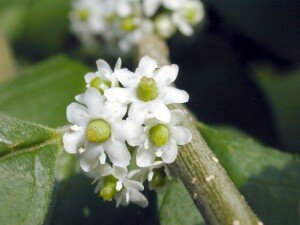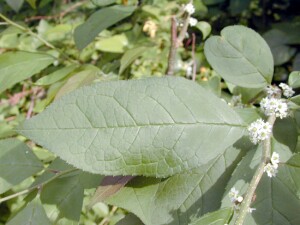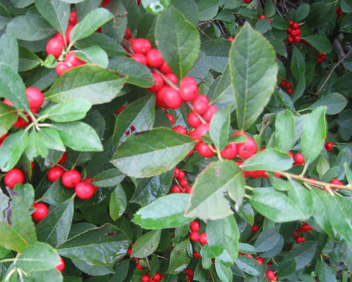Deck the halls... with this lovely holly
lex verticillata, or winterberry holly, is found throughout North America, east of the Mississippi River, from Canada to Florida. It is commonly found in swampy areas, and in full sun. Locally, you’ll have seen it along pond edges, and in the swampy areas close to woodlands. Close to my home, we’ve got beautiful wavy patches of it in the swampy areas of the headwaters of Cayuga Inlet just north of Walding Lane in West Danby.
Winterberry can easily be grown from cuttings taken from late spring to early summer, or from seeds collected in the winter. I have collected seeds from local shrubs and have had good germination success after two seasons. My plants won’t flower for another year or two. Ilex verticillata is dioecious so I’ll have to wait until they flower to see how many male and female plants I have. Plants in garden soils can be grown in full sun to partial shade, but produce more berries in sunnier locations. To get berries you’ll have to have female plants. One male planted in proximity to many females is usually enough to pollinate.
Ilex verticillata is a large shrub, which normally grows to about 10’ tall and 10’ wide. They have dark, smooth bark, and the twigs zig and zag rather than grow straight. The leaves are flat, medium to dark green, up to 4" long, doubly toothed, and turn a dull yellow in the fall. Locally, plants flower from May to June. The flowers are a creamy white and are about ¼" wide. If you are looking for flowers, look carefully, because they cluster inconspicuously on the stems. Or, if you have honeybees nearby, you will find the flowers by listening for the bees. The scarlet red to orange fruits are drupes, which grow up to 3/8" in diameter. Look for them to start getting color in October. Most plants keep their berries until mid-winter when the birds will harvest them. November and December seem to be the showiest months for winterberries.
While no plant is deer or rabbit proof, at least winterberries are not the preferred browse of deer, rabbit, and moose. I fence half of mine, and the unfenced ones are still fine, though perhaps tasted occasionally.
Ethnobotanically, the bark and roots of these plants have been used by the Iroquois for ailments of the digestive system, craziness, and hay fever. And while the berries are favored by winter resident birds, they are poisonous to humans. Twigs with berries make great additions to holiday decorations as well.Photo credits:
Flower/leaf: rmoran@nybg.org
Berry: Xiangying Wen
About
By Sarah McNaull
Photos by rmoran@nybg.org, Xiangying Wen, Seabrooke Leckie





